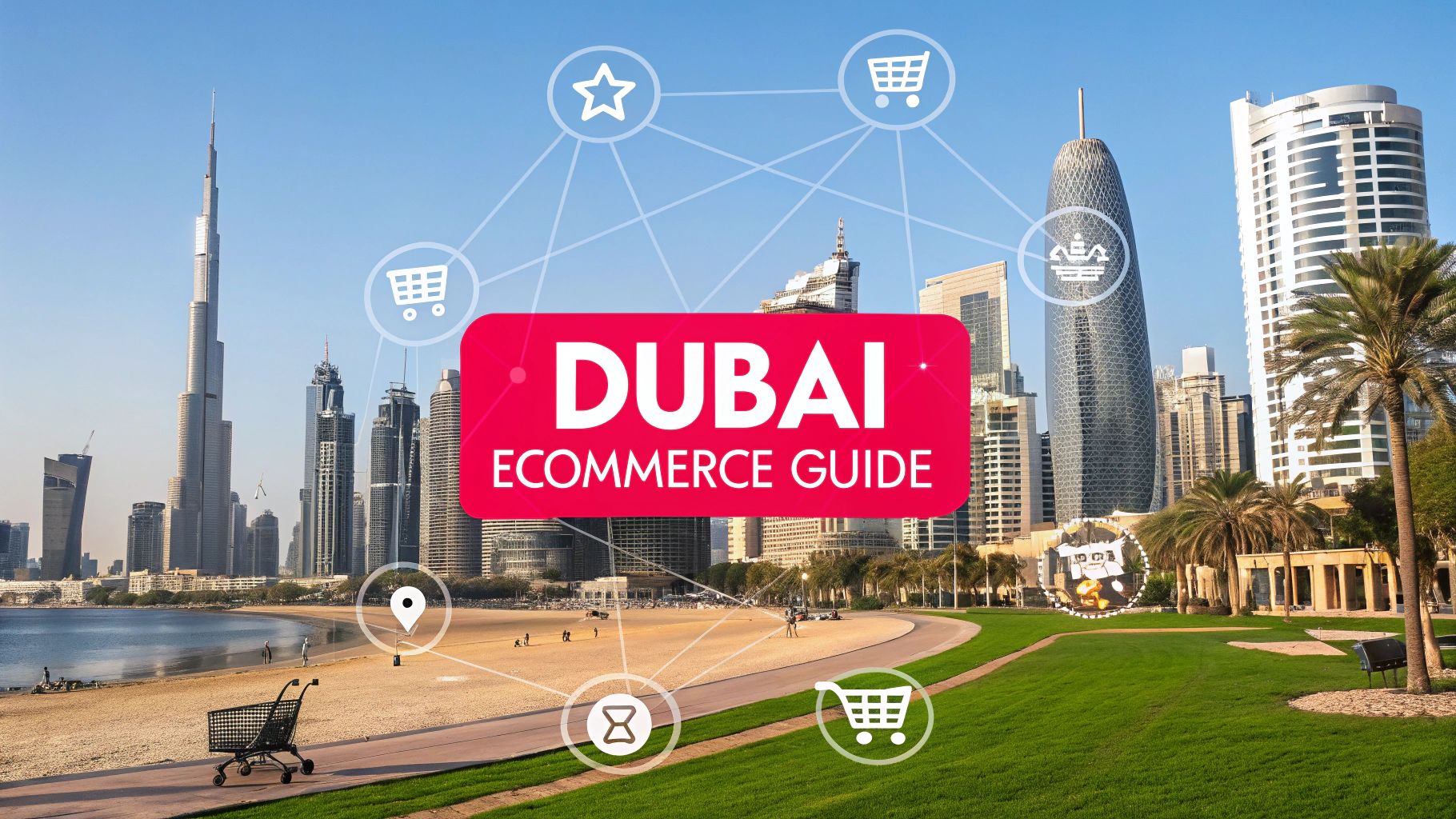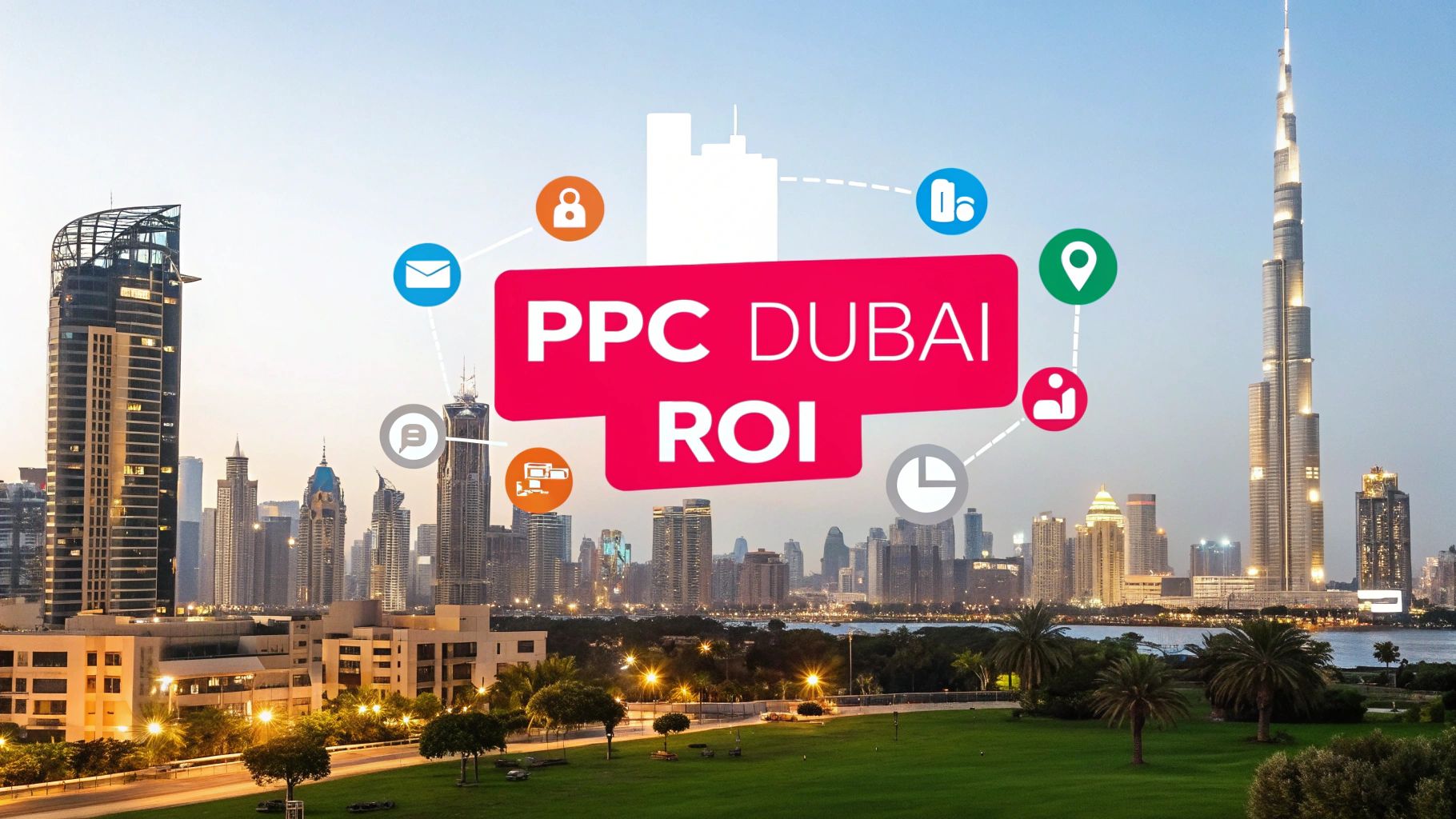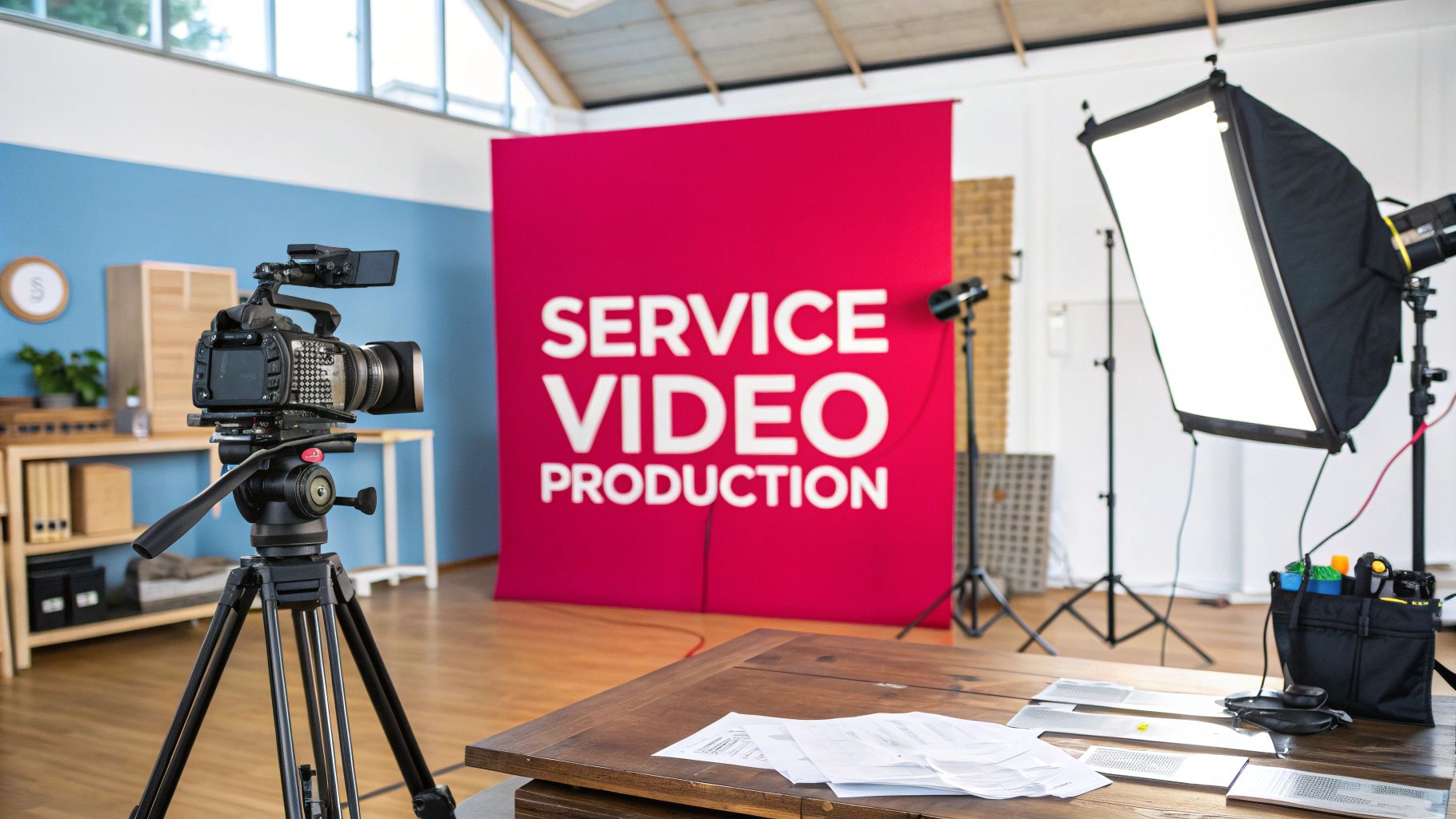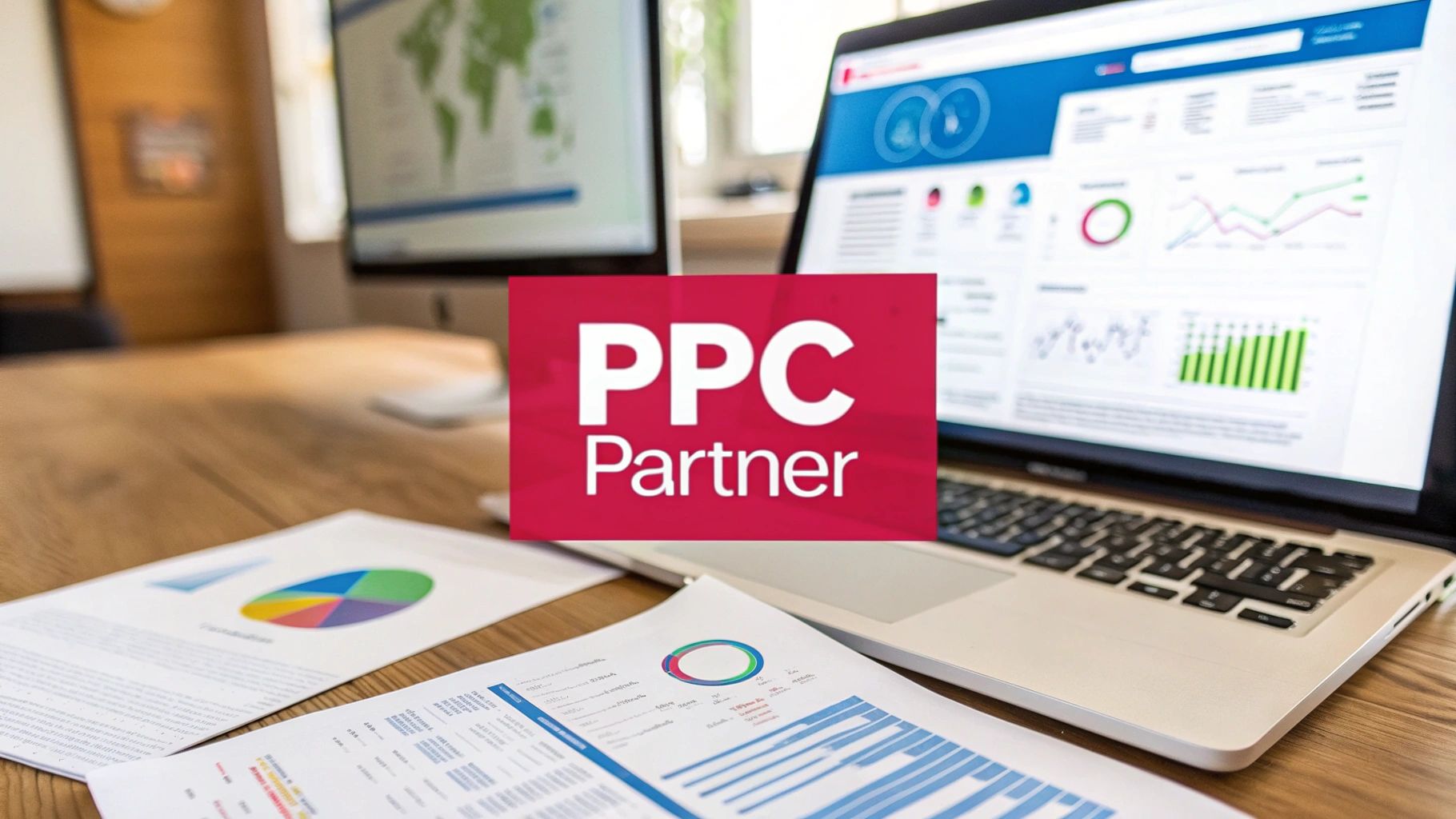When we talk about e-commerce website design in Dubai, we're not just talking about putting products online. It’s a specialised craft, one that involves creating an online store that feels right for the UAE market. Think of it as a careful mix of culturally smart design, a mobile-first approach, and seamless integration with local payment methods to meet the incredibly high standards of shoppers here.
Getting this right is everything. A smooth, secure, and intuitive experience is what builds trust and, ultimately, turns visitors into customers.
Your Blueprint for Digital Success in Dubai
Setting up an online store in Dubai is a world away from using a generic, off-the-shelf template. It’s more like building a flagship boutique in the Dubai Mall—your digital storefront needs that same level of detail, cultural awareness, and a flawless user journey to really connect with discerning customers. The local market has its own unique consumer habits and sky-high expectations for digital services, so a one-size-fits-all approach just won't cut it.
This guide is your complete roadmap for e-commerce website designing in Dubai. We’ll skip the generic advice and get straight to the practical insights that make a real difference, exploring what separates a thriving online business from one that’s just treading water.
Building for the Dubai Market
From the very beginning, your e-commerce platform has to be built with the local environment in mind. This means getting a solid grasp on a few key areas:
- Local Shopper Behaviour: We'll dive into what really motivates the tech-savvy and culturally diverse UAE consumer.
- Essential Technology Choices: We'll compare the platforms and frameworks that offer the best security and ability to grow with your business in this region.
- Payment and Logistics Integration: You'll find out which payment gateways and shipping partners are essential for running a smooth operation.
- Advanced SEO Strategies: We’ll cover how to get your store showing up in local search results for the right Arabic and English keywords.
Think of this guide as your architectural blueprint. Each section lays another critical part of the foundation, making sure the final structure is solid, attractive, and perfectly suited to its surroundings. Without this plan, you risk building a store that looks the part but just doesn't work in the competitive UAE market.
This all-in-one approach ensures your online store isn’t just launched, but truly engineered to succeed. By breaking down every component—from the first design ideas to sophisticated marketing tactics—we'll give you the knowledge you need to build a powerful and profitable e-commerce presence in one of the world's most exciting digital economies.
Getting to Know Dubai's Unique E-commerce Shopper

Before you even think about code or design, the first step in successful ecommerce website designing in Dubai is getting inside the head of the local customer. This isn't just about looking at demographics. It's about really understanding the specific cultural and digital habits that make UAE shoppers tick. They're a switched-on, diverse bunch with sky-high expectations for speed and convenience.
Picture this: a potential customer is browsing your store during a short taxi ride across town. They expect your site to load in a flash, look perfect on their phone, and have a checkout so simple they can finish their purchase before the trip ends. That’s not a wish list; it’s the standard. A slow, clunky experience means a lost sale—and they probably won't be back.
Mobile-First Isn't a Suggestion, It's the Rule
In the Dubai market, simply being "mobile-friendly" is old news. The only real approach is "mobile-first." This means you start the entire design and development process with the smallest screen in mind and then scale it up for desktops, not the other way around. This isn't just a trend; it’s a direct response to how people here actually shop.
Mobile commerce absolutely dominates online retail in the UAE, a fact that dictates everything about modern e-commerce website design in Dubai. A whopping 72% of all internet traffic in the UAE comes from mobile devices, so if you're not putting mobile first, you're ignoring the vast majority of your audience. You can dig deeper into numbers like these in this insightful article on website design statistics.
So, what does this mobile dominance mean for your site?
- Thumb-Friendly Navigation: All your important menus, buttons, and links need to be where a thumb can easily tap them.
- Keep Forms Simple: Make your checkout and sign-up forms as short as possible. Only ask for what you absolutely need to reduce the chances of someone giving up.
- Optimise Your Images: Product photos must look great, but they also need to be compressed so they load fast and don't eat up a customer's data plan.
The Power of Being Bilingual
Dubai is a true global hub, a melting pot of countless cultures and languages. While English is spoken everywhere, Arabic is the official language and carries immense cultural weight. If your website only speaks one language, you're closing the door on a huge chunk of your potential customers.
Providing a seamless, fully functional bilingual experience in both Arabic and English isn't just a nice-to-have feature. It’s an essential requirement for earning trust and credibility with local shoppers.
And this means much more than just a direct word-for-word translation. A properly bilingual site needs:
- Right-to-Left (RTL) Layout: The entire user interface must flip perfectly to accommodate Arabic, which is read from right to left.
- Cultural Sensitivity: Your marketing messages, promotions, and even your imagery need to make sense and feel right within the local culture.
- Easy Language Switching: Customers should be able to switch between Arabic and English with a single, obvious tap, no matter where they are on your site.
By building your strategy around these fundamentals—a mobile-first approach, the necessity of bilingual support, and a laser focus on speed—you set the stage for an e-commerce platform that doesn't just work in Dubai, but truly succeeds.
Core Pillars Of High-Converting E-commerce Design
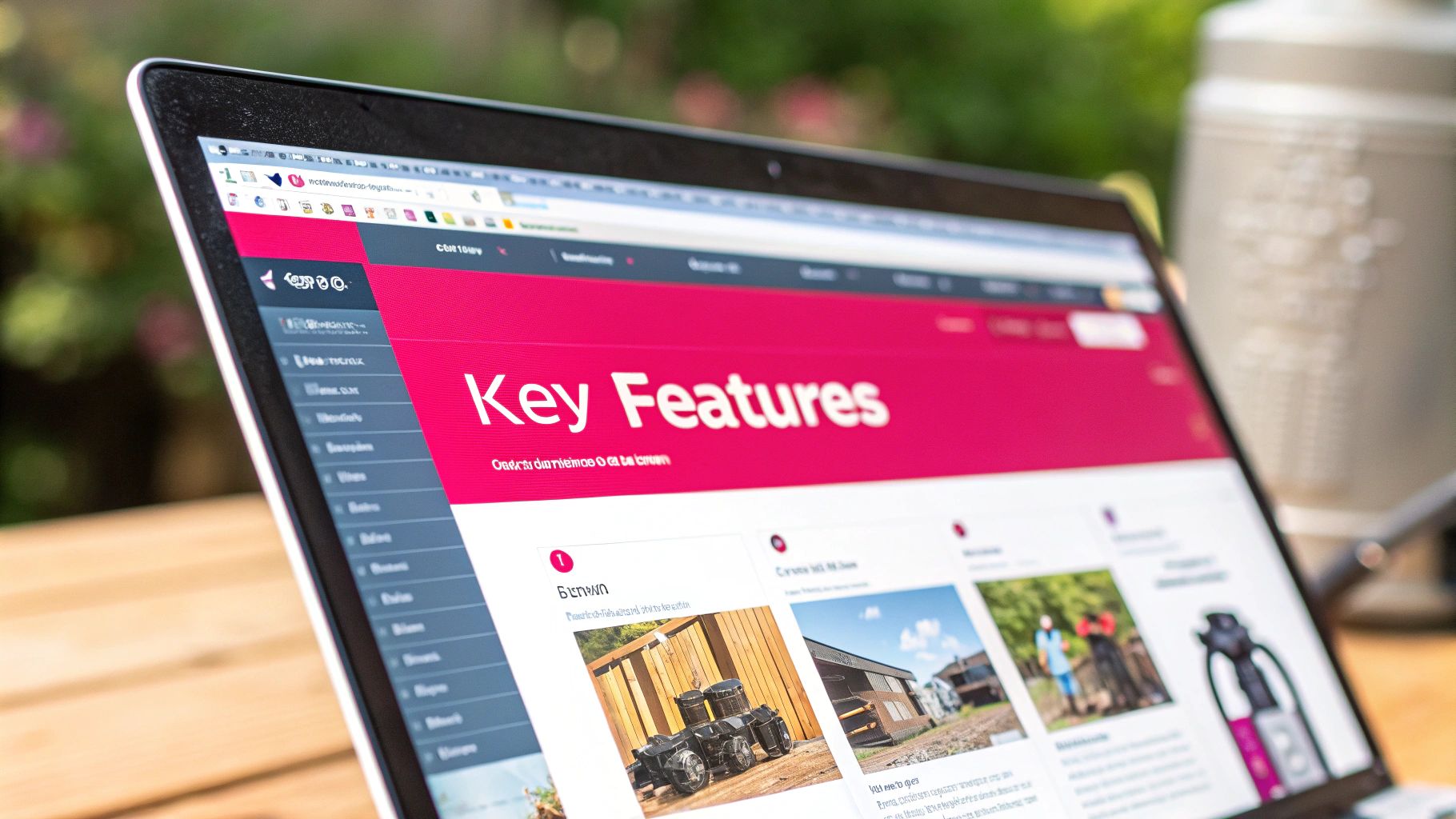
Understanding the Dubai shopper is just the first step. The real challenge is turning that insight into a digital storefront that not only looks great but also sells. A high-converting e-commerce site isn't built on luck; it's built on three core pillars that work in harmony to guide customers from their first click to the final checkout.
Think of it like building a physical store. You have the logical layout (User Experience), the visual appeal and branding (User Interface), and ensuring the entrance is wide enough for everyone (Mobile-First Architecture). Nail these three, and you've got a solid foundation for your online business.
Crafting An Effortless User Experience (UX)
User Experience, or UX, is the invisible framework of your website. It’s not about the colours or logos; it’s about how simple and intuitive your site is to navigate. A good UX feels completely natural, making it effortless for someone to find a product, pop it into their cart, and pay.
In a market as fast-paced as Dubai's, a confusing or clunky website is a guaranteed sale-killer. Shoppers here have zero patience for sites that make them work too hard. Your job is to remove every obstacle, creating a smooth path to purchase.
This comes down to a few key things:
- Intuitive Navigation: Your menus and categories must make immediate sense. A customer looking for "men's running shoes" shouldn't need a map to find them.
- A Powerful Search Bar: For stores with a lot of products, a smart search with filters for size, colour, and price isn't a luxury—it's essential. It helps people find exactly what they want, right away.
- A Streamlined Checkout: The checkout process should be a simple, step-by-step journey that shows clear progress. Only ask for the information you absolutely need and always offer a guest checkout option.
Designing A Visually Appealing User Interface (UI)
If UX is the store's floor plan, then the User Interface (UI) is the interior design—the colours, the lighting, the product displays. It’s everything your customer actually sees and interacts with. A great UI grabs attention, builds trust, and perfectly reflects who you are as a brand.
A top-tier UI needs to feel both modern and culturally relevant, striking a balance that resonates with local tastes while looking professional. This means high-quality photography and a clean, uncluttered layout are non-negotiable.
A strong UI does more than just make your site look good; it communicates professionalism and reliability. For Dubai shoppers who value quality and luxury, a polished visual presentation is a critical signal of a trustworthy business.
Of course, looks aren't everything if the site is slow. Technical performance is a huge part of the user experience, which is why focusing on aspects like WordPress Site Speed Optimization is so critical. A fast website feels like a quality website.
To help you focus your efforts, here's a breakdown of the key design elements and why they're so important in the Dubai market.
Key Design Focus Areas For Dubai E-commerce
| Design Element | Core Principle | Why It Matters in Dubai | Practical Example |
|---|---|---|---|
| High-Quality Imagery | Visual Storytelling | Shoppers value premium quality; professional photos and videos signal a high-end product. | Using 360-degree product views for luxury watches or high-fashion items. |
| Clear Typography | Readability | A diverse, multilingual audience requires fonts that are clear and legible in both English and Arabic. | Choosing a font like Tajawal that supports both Latin and Arabic scripts beautifully. |
| Brand Consistency | Trust Building | A consistent look across all pages reinforces brand identity and builds shopper confidence. | Using the same colour palette, logo, and fonts on product pages, checkout, and emails. |
| Responsive Design | Mobile Accessibility | The market is overwhelmingly mobile-driven. A non-responsive site is a non-starter. | Ensuring buttons are large enough for thumbs and forms are easy to fill on a phone. |
Getting these elements right ensures your site not only functions well but also connects visually and emotionally with your target audience.
Building On A Mobile-First Architecture
The final, and arguably most important, pillar is a mobile-first architecture. We know that most of your customers in Dubai will be shopping from their phones. This means your website has to be designed for the small screen first and then adapted for desktops—not the other way around.
This approach guarantees the mobile experience is flawless, not just a shrunken-down, clumsy version of the desktop site. Buttons need to be easy to tap, text has to be readable without zooming, and the entire site must load quickly, even on a mobile network.
By focusing on these three pillars—UX, UI, and a mobile-first foundation—you’re not just building a website. You’re creating a powerful sales engine perfectly tuned for the high expectations of the Dubai market. This strategic thinking is at the heart of our comprehensive Dubai ecommerce website design services.
Choosing The Right Technology Stack And Platform
Picking the technology for your online store is a bit like choosing the engine for a performance car. It’s what dictates your speed, reliability, and how easily you can add more power later on. The decision you make right now will ripple through every part of your business, from daily operations to your big-picture growth plans.
This isn’t just about going with a familiar name; it’s a foundational strategic choice. You need a platform that not only gets you started but can also keep up as your business takes off. It has to handle the unique demands of the Dubai market and, most importantly, provide rock-solid security to protect your customers' data.
Comparing The Top E-commerce Platforms
For anyone setting up shop in the UAE, the choice usually boils down to three heavyweights: Shopify, Magento (now Adobe Commerce), and WooCommerce. Each one strikes a different balance between ease of use, creative control, and cost.
Let's break them down.
-
Shopify: Think of Shopify as a premium, all-inclusive rental. It gives you everything you need right out of the box—hosting, security, and a super clean interface—all in one package. It’s incredibly fast to get up and running, which makes it perfect for startups and small businesses keen to launch quickly.
-
WooCommerce: If Shopify is a high-end rental, then WooCommerce is like owning your own property built on the world's most popular foundation, WordPress. It gives you incredible flexibility and control, with a massive world of plugins that let you add almost any feature you can dream up.
-
Magento (Adobe Commerce): This is the enterprise-level beast, built for massive operations with complex product catalogues and huge traffic volumes. Magento offers unmatched scalability and customisation, but it demands serious technical skill and a significant investment to manage properly.
The right platform is the one that lines up perfectly with your business goals, budget, and technical comfort level. A small fashion boutique has entirely different needs than a large electronics retailer, and their technology choice should reflect that.
Key Factors For The Dubai Market
When you're weighing these options, a few things are especially important for making it in Dubai. Your chosen tech has to effortlessly meet the specific expectations of local shoppers.
First up is scalability. Your platform has to grow with you. A successful launch can bring a flood of new traffic and sales, and your website needs to handle that spike without slowing to a crawl or crashing completely.
Next, security is absolutely non-negotiable. When you're handling online payments, you're responsible for protecting sensitive customer information. A platform with a strong security reputation and consistent updates is vital for building trust.
Finally, multilingual support is essential. As we've touched on, offering a flawless experience in both Arabic and English is the bare minimum. This isn't just about translating text; it means full support for Right-to-Left (RTL) layouts to ensure your site looks and works perfectly for Arabic speakers.
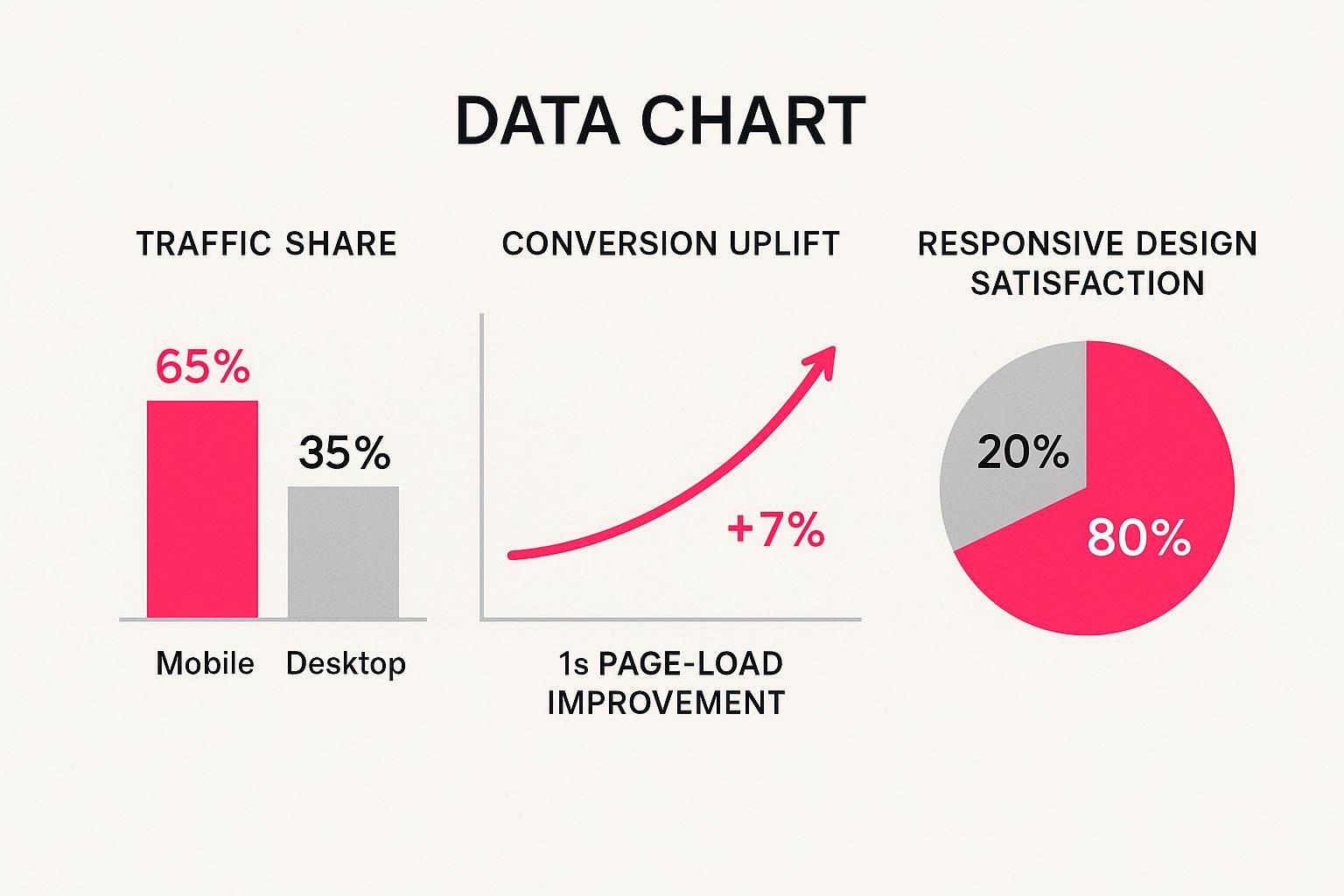
The data here is crystal clear: a fast, mobile-friendly design isn't just a nice-to-have. It’s a core driver of customer happiness and, ultimately, your revenue in the UAE market.
Local Integration Capabilities
Beyond the platform itself, what really makes an e-commerce store run like a well-oiled machine in the UAE is its ability to connect with local services. Your technology must seamlessly link up with the payment gateways and shipping companies that customers here already know and trust.
This means you need to check for pre-built integrations or easy-to-use APIs for:
- Payment Gateways: Services like Telr and PayFort are must-haves.
- Buy Now, Pay Later (BNPL): Smooth integration with Tabby and Tamara is critical.
- Shipping Providers: Direct connections to couriers like Aramex are necessary for efficient logistics.
Making the right call here requires a clear-eyed view of what your business truly needs. For a more detailed look at how all these pieces fit together, check out our guide on e-commerce website development in Dubai. This decision is the technical foundation you'll build your entire digital business on.
Getting Payments and Deliveries Right in Dubai

You can have a stunning website and the best products in the world, but if paying and getting the delivery is a headache, you’ll lose the sale. This is the operational backbone of your business—where a curious browser turns into a happy customer. For a successful ecommerce website in Dubai, getting your local payment and delivery partners locked in isn't just a feature; it's the heart of the entire customer experience.
Think of it as a relay race. Your website design and product pages carry the baton perfectly, but the final handover to payment and shipping needs to be just as smooth. Fumble here, and you’ve dropped the baton right at the finish line.
Choosing the Right Local Payment Gateways
Sure, global giants like Stripe exist, but to truly connect with UAE shoppers, you need to integrate with local payment gateways they already know and trust. These gateways are built for this market, handling multiple currencies and offering checkout experiences that feel familiar, which drastically cuts down on abandoned carts.
Two of the biggest names you'll come across are:
- Telr: A fantastic option for startups and SMEs. Telr offers flexible plans and handy features like payment links, making it easy to sell through social media. It integrates smoothly with platforms like Shopify and WooCommerce, making it a solid choice for new businesses.
- PayFort (an Amazon company): Now operating as Amazon Payment Services, this is a real powerhouse. It offers top-tier security and advanced features like tokenisation, which is great for subscription models. It’s a name that consumers across the region recognise and trust implicitly.
When you're picking a payment gateway, don't just get fixated on the transaction fees. You need to look at how easily it plugs into your ecommerce platform, the quality of their support team, and the variety of payment methods they offer. This decision directly shapes how smoothly your business runs and how much your customers trust you.
Embracing How Dubai Actually Pays
Beyond just accepting credit cards, the Dubai market has some very specific payment habits you simply can't ignore. Offering these local options shows customers you understand them.
Cash on Delivery (COD)
Even in a highly digital city, Cash on Delivery (COD) is still king for many. It gives shoppers a sense of security—they can physically see the product before parting with their money. Yes, it adds logistical challenges like managing cash and processing returns, but not offering it means you could be shutting the door on a huge chunk of your potential customers.
Buy Now, Pay Later (BNPL)
The growth of Buy Now, Pay Later (BNPL) in the UAE has been nothing short of explosive. Services like Tabby and Tamara are now household names, letting customers split their payments into smaller, interest-free instalments. Integrating a BNPL option can seriously boost your conversion rates, especially for more expensive items, by making them feel more affordable.
Connecting With Reliable Logistics Partners
Payment sorted? Great. Now for the final, crucial step: getting the product into your customer’s hands. Your delivery partner is a direct reflection of your brand. A late parcel or a damaged box reflects poorly on you, not just the courier company.
Partnering with a local logistics champion like Aramex is a smart move. Their vast network across the UAE and the wider region means you can count on timely deliveries. Modern e-commerce platforms offer deep integrations with these providers, which unlocks some fantastic features:
- Real-time shipping rates calculated automatically at checkout.
- Automated shipping label generation to speed up your packing process.
- Live tracking updates for customers, giving them peace of mind and cutting down on "Where's my order?" emails.
Nailing this operational side of things is also key for your local visibility. When you can reliably serve your area, you can confidently market to customers nearby. To learn more about that, check out our guide on how to win with local SEO in Dubai for practical steps to get your business seen by the right people.
Advanced Strategies to Elevate Your Online Store
Having a functional and well-designed e-commerce store is really just the starting line in Dubai's crowded market. To actually pull ahead of the competition, you need to think beyond the basics. It’s about implementing those next-level strategies that create truly memorable customer experiences.
Think of it like this: your basic website is a solid, reliable car. It gets you where you need to go. These advanced strategies are the high-performance upgrades—the turbocharger, the precision handling, the bespoke interior—that make the entire journey faster, smoother, and far more enjoyable for your customers.
Harnessing the Power of Artificial Intelligence
AI is no longer just a buzzword; it's a fundamental tool for smart ecommerce website designing dubai. Its real magic lies in its ability to understand and even predict what your customers want, letting you offer a level of personalisation that was once unthinkable. It makes the entire shopping experience feel like it was built just for them.
A great example is AI-driven product recommendations. Instead of just showing a generic "bestsellers" list, AI digs into a user's browsing history, past purchases, and even how long they’ve looked at certain items. It then suggests products they're genuinely likely to be interested in, which naturally pushes up the chances of a sale.
By intelligently personalising the shopping journey, you make customers feel seen and understood. This not only boosts conversions but also fosters a powerful sense of loyalty that generic, one-size-fits-all websites simply cannot replicate.
This isn't just a fleeting trend; it’s shaping the future of the market. AI is set to play a huge part in how e-commerce websites are designed in Dubai, with AI-powered personalisation expected to be a dominant trend in 2025. UAE businesses are already using AI algorithms to analyse customer behaviour in real-time, delivering tailored product suggestions and customised shopping journeys. You can get more insight into how AI is shaping UAE web design on btlstudio.com.
Immersive Experiences With Video and AR
Let's be honest, static product images just don't cut it anymore. Today's shoppers expect more. Immersive tech like high-quality video and Augmented Reality (AR) helps close the gap between browsing online and actually being in a physical store, giving customers the confidence boost they need to click "buy now."
-
High-Quality Product Videos: A well-shot video can showcase a product’s features, demonstrate its true size, and convey a sense of quality that a simple photo never could. For a fashion brand, it might be a model wearing a dress. For an electronics shop, it could be a quick demo of a new gadget.
-
Augmented Reality (AR) Try-Ons: This technology is a game-changer, especially for industries like fashion, cosmetics, and furniture. AR lets customers use their phone’s camera to see how a new pair of sunglasses might look on them or if that stylish sofa actually fits in their living room. This kind of interactive experience clears up doubt and is proven to significantly lift conversion rates.
Dominating Local Search With Advanced SEO
You can have the most beautiful online store in the world, but if nobody can find it, it doesn't matter. While basic SEO is a must, advanced local SEO tactics are what will really set you apart in the UAE. This means digging deeper than just broad, generic keywords.
A huge part of this is focusing on Arabic keyword research. A significant portion of shoppers in the region search in Arabic, often using specific local dialects and phrases. Finding and targeting these keywords is essential for reaching this incredibly valuable audience. It’s also vital to optimise for local search intent—making sure your Google Business Profile is fully updated and you're targeting location-specific searches like "designer handbag delivery in Jumeirah."
Of course, to make sure your stunning e-commerce store actually connects with its audience, you have to master digital marketing. To learn more about getting qualified traffic to your site, it’s worth exploring some Search Engine Marketing best practices.
Frequently Asked Questions
Thinking about launching an e-commerce site in Dubai? You've probably got a lot of questions swimming around. Below, I’ve answered some of the most common ones we hear from entrepreneurs just like you, breaking down everything from costs and timelines to the must-have features for this market.
Let's clear up the confusion so you can move forward with your project.
How Much Does Ecommerce Website Designing Cost in Dubai?
The cost of building an e-commerce website in Dubai isn't a one-size-fits-all answer. It really hinges on what you need. If you're starting out, a clean and simple store using a platform like Shopify can get you up and running for just a few thousand dirhams. It's a fantastic entry point for new businesses.
But if you're picturing a custom-built powerhouse on a platform like Magento, with unique features and complex system integrations, the investment is naturally higher. These projects can range anywhere from AED 50,000 to over AED 200,000. The final price tag comes down to the technology, design complexity, and the number of bespoke functions you need.
What Are The Most Important Features For A Dubai Ecommerce Site?
To truly connect with customers in the UAE, a few features are absolutely essential. First and foremost, you need a flawless, mobile-first design. The vast majority of shoppers here browse and buy on their phones, so a clunky mobile experience is a deal-breaker. Equally critical is full bilingual support for both Arabic and English to serve the city’s diverse population.
Local payment preferences are another big one. It's not just about credit cards.
You absolutely have to offer popular local options like Cash on Delivery (COD) and 'Buy Now, Pay Later' services. Integrating with providers like Tabby and Tamara isn't just a nice-to-have; it's a huge factor in building trust and boosting sales.
How Long Does It Take To Build An Ecommerce Website In Dubai?
The timeline really depends on the scope of the project. A straightforward, template-based site on a platform like Shopify or WooCommerce can be launched fairly quickly, often within 4 to 8 weeks. This is a great route if speed to market is your top priority.
On the other hand, a fully custom build is a much deeper dive. These projects, with their unique designs and specialised functions, require dedicated time for discovery, design, development, and thorough testing. You should plan for a timeline of 3 to 6 months, and sometimes even longer, to get it just right.
Do I Need A Trade Licence For Ecommerce In Dubai?
Yes, absolutely. To operate an e-commerce business legally in Dubai, you must have a valid trade licence. This isn't a step you can skip—it's a fundamental requirement for accepting payments and running your business within the UAE.
You can get an e-commerce licence directly from the Department of Economic Development (DED) or through one of Dubai’s many free zones. Getting this sorted ensures you’re fully compliant with local laws and can operate without any hitches.
At Grassroots Creative Agency, we build high-performance e-commerce websites that are perfectly tuned for the Dubai market. Get in touch with us today to build an online store that drives real results.

